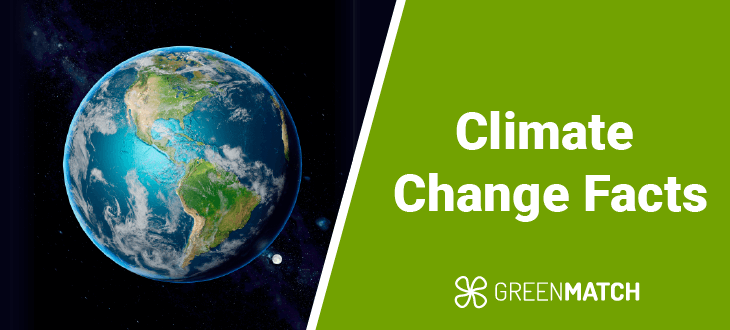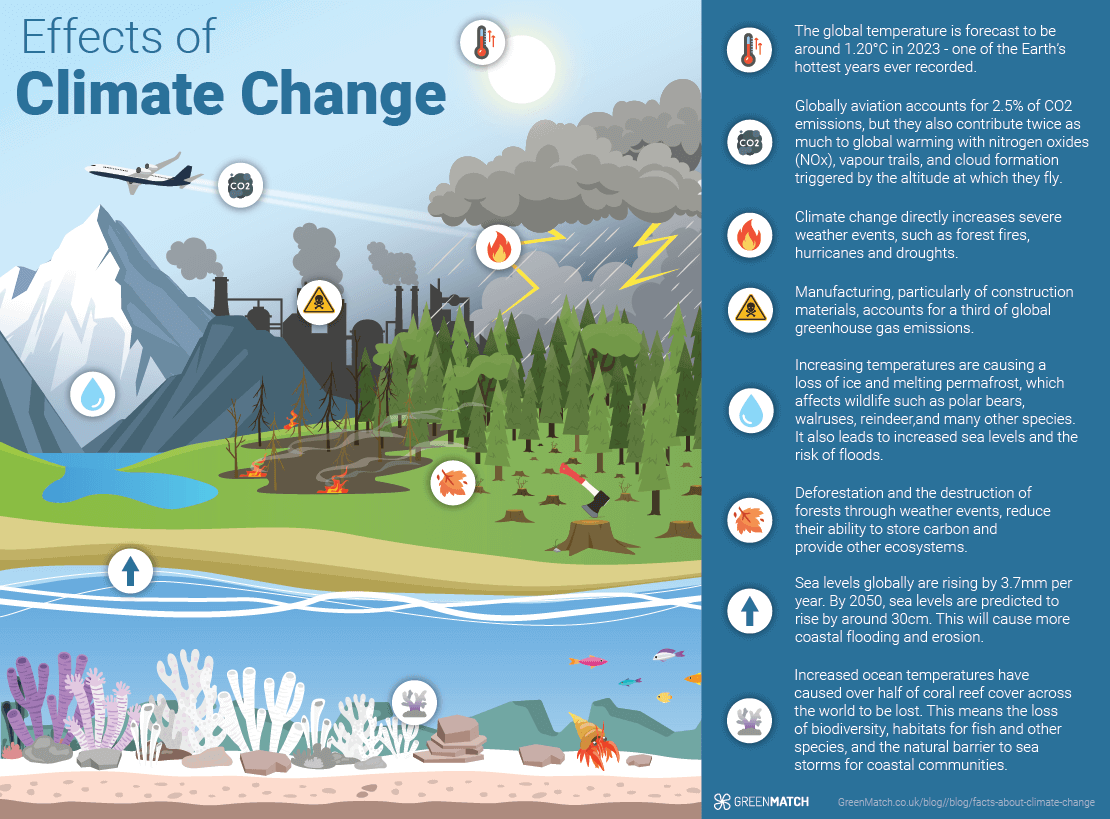- GreenMatch
- Blog
- 52 Climate Change Facts That You Need To Know
52 Eye-Opening Climate Change Facts You Need to Know 2025


In our rapidly changing world, few issues demand as much global attention and urgency as climate change. Unrelenting and vast in its impact, climate change has far-reaching effects on our planet's ecosystems, wildlife, and even our existence.
Climate change has been proven to be a direct cause of human actions, like burning fossil fuels and destroying natural environments. According to NASA, the experts on our planet:
It is undeniable that human activities have produced the atmospheric gases that have trapped more of the Sun’s energy in the Earth system. This extra energy has warmed the atmosphere, ocean, and land, and widespread and rapid changes in the atmosphere, ocean, cryosphere, and biosphere have occurred.
We've gathered key data from leading experts to help make sense of these climate change facts and what they mean for our future. These eye-opening statistics clearly show our challenges and the urgent need for action.

What Is Climate Change?
Climate change is a direct effect of global warming. Global warming is the effect of human activities on our planet’s atmosphere, which causes temperatures to rise. We do this by creating excessive greenhouse gases (such as carbon dioxide), which get trapped in the Earth’s atmosphere.
As the Earth heats, changes to our weather and our known environments start to occur, as well as devastating events like melting ice caps, rising sea levels, and extreme weather events like hurricanes and wildfires.
Collectively, these changes are known as ‘climate change’, and since the dawn of the Industrial Revolution, the impact of these events has been increasing, with more frequent and devastating effects being seen in recent years.
Although some people do not believe that climate change is caused by human activity, research groups worldwide are concluding that this is true, without a doubt. According to the IPCC (The Intergovernmental Panel on Climate Change):
Human-induced climate change, including more frequent and intense extreme events, has caused widespread adverse impacts and related losses and damages to nature and people, beyond natural climate variability. The rise in weather and climate extremes has led to some irreversible impacts as natural and human systems are pushed beyond their ability to adapt.
Public Perception and Support for Climate Change Action
Concern about climate change varies by region. For example, 85% of French adults and 92% of Turkish describe climate change as a major threat, higher than the 77% of Americans who share this view. This shows a significant increase in people worldwide who are increasingly concerned about climate change. For instance, in 2022, 71% of respondents across various countries considered climate change a major threat, up from 54% in 2014.
- Global Concern: Most people worldwide are concerned about climate change. Surveys indicate that in many countries, over 60% of the population views climate change as a major threat.
- Support for Renewable Energy: There is widespread support for renewable energy sources. For instance, in the European Union, around 90% of people support using renewable energy to combat climate change.
- Policy Support: Many people favour government policies aimed at reducing carbon emissions. In the United States, most of the population supports regulations to limit greenhouse gas emissions from power plants and other industrial sources.
- Youth Engagement: Younger generations show higher concern and support for climate action. Surveys reveal that young people are likelier to participate in climate strikes and advocate for stronger climate policies.
- Economic Perspectives: There is a growing recognition that addressing climate change can bring economic benefits. Many believe transitioning to a green economy can create jobs and drive innovation.
This data shows that a higher share of respondents from developing economies believe that climate change is a crisis impacting their lives. Over 70% of people in countries like the Philippines and Vietnam expressed this view.
Recent research across multiple domains provides valuable insights into these critical issues.
Temperature Rise Facts
Climate change is heating our planet at an alarming rate. Here are some sobering facts about global temperature increases:
1. The planet's average surface temperature has risen about 2°C since the late 19th century, driven largely by increased carbon dioxide emissions into the atmosphere and other human activities. (NASA)
2. Greenhouse gas concentrations are at their highest levels in 2 million years and continue to rise. As a result, the earth is about 1.1°C warmer than it was in the 1800s. The last decade was the warmest on record. (United Nations)
3. Earth’s average surface temperature in 2020 statistically tied with 2016 as the hottest year on record, continuing a long-term warming trend due to human activities. April 2024 was the warmest globally, with temperatures 1.32°C above the 20th-century average so far.
4. In a 2018 report, scientists and government reviewers agreed that limiting global temperature rise to no more than 1.5°C would help us avoid the worst climate impacts and maintain a livable climate. Yet the current path of carbon dioxide emissions could increase global temperature by as much as 4.4°C by the end of the century.
5. While Earth’s climate has changed throughout its history, the current warming is happening at a rate not seen in the past 10,000 years.
6. Globally, January 2023 was the seventh-warmest January on record. According to predictions, 2023 will rank among the 10 warmest years on record. The temperature reached 2023, the hottest year on record, with global temperatures consistently more than 1°C above pre-industrial levels. Notably, two days in 2023 exceeded 2°C above the 1850-1900 average, marking the first time this threshold was surpassed.
7. According to the IPCC’s sixth assessment report on our climate, the past decade is likely the hottest period in the last 125,000 years.
8. The last 22 years have seen 20 of the warmest years on record, according to The World Meteorological Organization (WMO).
9. The world’s five warmest years have all occurred since 2015, with nine of the 10 warmest years occurring since 2005, according to scientists from NOAA’s National Centers for Environmental Information.
10. NASA scientists also found that 2010 - 2019 was the hottest decade ever recorded.
11. Scientists from the UK Met Office determined that 2019 was one of the world's top three hottest years.
12. The latest report from the Intergovernmental Panel on Climate Change (IPCC) claims:
Beyond 2040, and depending on the level of global warming statistics, environmental change data will lead to numerous risks to natural and human systems. [...] If global warming transiently exceeds 1.5°C in the coming decades or later (overshoot), then many human and natural systems will face additional severe risks, compared to remaining below 1.5°C [...] Depending on the magnitude and duration of overshoot, some impacts will cause the release of additional greenhouse gases and some will be irreversible.
Air Quality
13. Combined, the 100 countries that emit the least gases only generate 3 per cent of all global emissions. On the other hand, just 10 of the largest emitters contribute 68 per cent of total emissions.
14. The concentration of carbon dioxide (CO2) in our atmosphere in May 2020 was
416 parts per million. As of May 2022, this increased to 421 parts per million, the highest in human history. (NOAA)
15. Human activities have raised the atmosphere’s carbon dioxide content by 50% in less than 200 years.
16. The concentration of greenhouse gases in the Earth’s atmosphere is directly linked to the average global temperature on Earth. The concentration has risen steadily, and global temperatures have risen since the Industrial Revolution.
17. The most abundant greenhouse gas, accounting for about two-thirds of greenhouse gases, carbon dioxide (CO2), is largely the product of burning fossil fuels.
18. Methane, the primary component of natural gas, is responsible for more than 25 per cent of the warming we are experiencing today. It is a powerful pollutant with a global warming potential over 80 times greater than CO2 during the 20 years after it is released into the atmosphere. (UNEP)
19. Over the last 50 years, the concentration of carbon dioxide in the atmosphere has increased by 30% due to the burning of fossil fuels and greenhouse gas emissions like carbon dioxide, nitrous oxide and other gases, trapping more heat in the lower atmosphere.
20. The last time carbon dioxide levels on our planet were as high as today was more than 4 million years ago.
21. Globally, aviation accounts for 2.5% of CO2 emissions. Still, they also contribute twice as much to global warming with nitrogen oxides (NOx), vapour trails, and cloud formation triggered by the altitude at which they fly.
22. The frequency of more intense hurricanes, ranked as categories 4 and 5, has increased over the last 30 years. These destructive hurricanes put more people at risk, and the increased frequency makes it more difficult to escape them.
23. There is potential to reverse the impact of global warming. If all emissions were to stop, the planet would gradually cool. However, rising sea levels, on the other hand, would take millennia to be reversed. (Carbon Brief). This is comparable to January 2024, which saw the highest global sea surface temperatures on record for that month, indicating a continuing trend of rising ocean temperatures.
Land Impact
24. Climate change can directly impact our forests through changes in temperature and precipitation, which can affect carbon storage, roots, soil and tree growth. Climate change can affect a tree's life cycle, reducing growth and increasing outbreaks of pests and plant disease. This creates a knock-on effect on surrounding wildlife and the production of forest products for human use. (Environmental Protection Agency)
25. Climate change enhances the drying of organic matter in forests, which is the material that burns and spreads wildfire and has doubled the number of large fires between 1984 and 2015 in the western United States. Warmer temperatures and drier conditions help fires spread and make them harder to put out.
26. According to the WMO, the area and intensity of wildfires have increased in recent years. Unprecedented wildfires caused devastation in 2020 across Australia, the Amazon and Central Asia.
27. The consequences of climate change now include, among others, intense droughts, water scarcity, severe fires, rising sea levels, flooding, melting polar ice, catastrophic storms and declining biodiversity.
Ocean Impact
28. Sea levels globally are rising by 3.7mm per year. By 2050, sea levels are predicted to rise by around 30cm. This will cause more coastal flooding and erosion.
29. Our global ocean has a very high heat capacity, Covering more than 70% of Earth’s surface.
30. Around 90% of global warming is occurring in the ocean. Heat stored in the ocean causes its water to expand, which is responsible for one-third to one-half of the rise in global sea level.
31. The ocean has become a kind of ‘sink’ for our planet, absorbing around one-third of the carbon in our atmosphere. Before the Industrial Revolution, the ocean was a carbon source, but the massive amount of CO2 in the atmosphere has forced it to start absorbing the gas.
32. The last 10 years were the ocean’s warmest decade since at least the 1800s. 2022 was the ocean’s warmest recorded year and saw the highest global sea level.
33. The top 100 metres of the ocean have been warming by 0.33 degrees Celsius since 1969.
34. The acidity of surface ocean waters has increased by about 30% since the beginning of the Industrial Revolution. This increase is directly caused by more carbon dioxide in the atmosphere and, therefore, more being absorbed into the ocean.
35. The effects of ocean warming include sea level rise due to thermal expansion, coral bleaching, accelerated melting of Earth’s major ice sheets, intensified hurricanes, and changes in ocean health and biochemistry.
36. Coastal cities around the world are affected by rising sea levels. Indonesia is moving its capital city away from Jakarta. Home to over 10 million people, Jakarta is one of the fastest-sinking cities in the world. Researchers predict that large parts of the city could be completely submerged by 2050.
37. Global sea levels rose about 20 centimetres in the last century. However, the rate in the last two decades has nearly doubled that of the last century and is accelerating yearly.
38. Increased ocean temperatures have caused over half of coral reef cover worldwide to be lost. This means the loss of biodiversity, habitats for fish and other species, and the natural barrier to sea storms for coastal communities.
39. A recent study suggests that approximately 14% of the world’s coral reefs were lost in 2008 and 2019 due to rising ocean temperatures caused by climate change, overfishing, coastal development, and declining water quality.
40. Scientists have estimated that coral reefs are at risk of being completely wiped out by 2050.
41. The Golden Toad is the first species to go extinct due to climate change. Research suggests that half of all amphibians are at risk of extinction due to climate change. Although many argue that extinction is a natural phenomenon, some experts suggest we’re in the midst of the sixth mass extinction caused mostly by human activity.
Arctic Warming: Ice Loss
42. Since the mid-1990s, the world has lost around 28 trillion tons of ice, with the current melt rate at 1.2 trillion tons per year. This is equivalent to the combined weight of all human-made objects on Earth. This figure is hard to comprehend, but it roughly equates to around the same weight as all living things on Earth - the quantity at which we lose ice yearly.
43. Antarctica is losing ice mass (melting) at an average rate of about 150 billion tons per year, and Greenland is losing about 270 billion tons per year, adding to sea level rise.
44. Both the Arctic and Antarctic oceans recorded their second-smallest average annual sea-ice coverage during the 1979–2019 period of record. The extent and thickness of Arctic sea ice have declined rapidly over the last several decades.
45. This is important because the ice sheets of Greenland and Antarctica store about two-thirds of all the freshwater on Earth. They are losing ice due to the Earth’s surface and ocean warming. Meltwater coming from these ice sheets is responsible for about one-third of the global average rise in sea level since 1993.
46. Glaciers are retreating almost everywhere worldwide — including in the Alps, Himalayas, Andes, Rockies, Alaska, and Africa. Satellite observations reveal that the amount of spring snow cover in the Northern Hemisphere has decreased over the past five decades, and the snow has been melting earlier. (National Grid)
Human Life
47. A recent report by Oxfam found that climate change could increase food prices by 50-60% per cent more by 2030. This is due to increased weather events such as flooding or droughts directly impacting food production worldwide.
48. Over the past decade, 1.7 billion people have been affected by extreme weather and climate-related disasters. (WFP)
49. In 2019, 302.4 billion working hours were lost due to excessive heat. Around the world, hotter temperatures make many places too dangerous to work or live outdoors. A report by The Lancet found that businesses suffer from rising temperatures and lose the equivalent of 88 hours per employee.
50. A recent study found that by 2070, many places may become too hot to live in. The study concluded that if emissions continued, temperatures could rise to unbearable levels, affecting up to 3 billion people.
51. Climate change can have serious health impacts, such as heat stress or extreme cold, which can cause deaths due to overheating or hypothermia. The change in temperatures and longer life expectancy have also increased temperature-related deaths in the elderly. (The Lancet)
52. As climate change can affect our health, food supply and even our ability to live in certain areas, the crisis has reached the point where more communities will soon have to relocate. It is expected that around 1.2 billion new climate refugees could result from natural disasters and other weather-related events by 2050, including immigrants who are forced to flee due to natural disasters, such as volcanoes and tsunamis.
Scale and Urgency of the Climate Crisis
Some countries have successfully decoupled economic growth from CO2 emissions. For instance, the UK and the European Union have significantly reduced their emissions while growing their economies. Human emissions of greenhouse gases are the primary driver of climate change. CO2 levels have reached their highest in 2 million years, standing close to 420 parts per million (ppm) today, compared to pre-industrial levels of around 280 ppm.
Many individuals are willing to make personal sacrifices to combat climate change. This includes reducing energy consumption, using public transportation, and supporting eco-friendly products. However, increased awareness of climate change does not always translate into significant behavioural changes. While there is a broadly positive attitude towards climate protection, actual changes in consumption and lifestyle decisions are less pronounced.
Notable shifts include increased green electricity contracts and CO2 compensation for air travel. A majority of people support policies aimed at mitigating climate change. For example, 86% of people in the world favour developing renewable energy sources over expanding fossil fuel production.
These climate change facts make one thing clear: our planet is changing, and we need to act now. While the challenges are significant, there's still hope. Understanding these facts and taking action in our daily lives can contribute to a more sustainable future.
Whether it's reducing our carbon footprint, supporting renewable energy, or advocating for climate-friendly policies, every action counts. Let's use these climate change facts to catalyse positive change and work together to protect our planet for future generations.

Becky is an experienced SEO content writer specialising in sustainability and renewable trends. Her background in broadcast journalism inspires reliable content to help readers live more sustainably every day.
We strive to connect our customers with the right product and supplier. Would you like to be part of GreenMatch?





